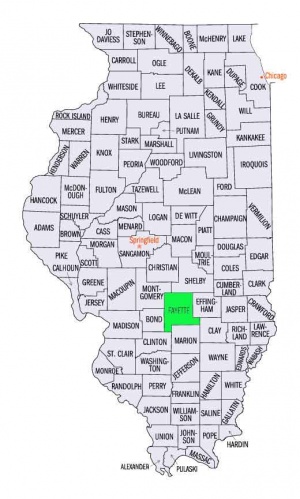Difference between revisions of "Fayette County Old Order Amish Settlement (Fayette County, Illinois, USA)"
GameoAdmin (talk | contribs) (CSV import - 20130820) |
GameoAdmin (talk | contribs) (CSV import - 20130823) |
||
| Line 1: | Line 1: | ||
| − | [[File:IL-Fayette.jpg|300px|thumb|right|''Fayette County, Illinois | + | [[File:IL-Fayette.jpg|300px|thumb|right|''Fayette County, Illinois |
| − | U.S. Census TIGER/Line | + | U.S. Census TIGER/Line |
| − | map | + | map'']] The Fayette County, [[Illinois (USA)|Illinois]], [[Old Order Amish|Old Order Amish]] community, now extinct, was located near Brownstown and Vandalia in 1894-1906. The community at its largest consisted of about 25 families. John A. Miller was the first minister, and he was joined by Mose Yoder of [[Howard-Miami County Amish Settlement (Kokomo, Indiana, USA)|Howard County]], [[Indiana (USA)|Indiana]]. Sam Bender was ordained minister and bishop of the church. Joe Bontrager, who lived in the community for about two years, also assisted in preaching. |
| − | |||
| − | '']] The Fayette County, [[Illinois (USA)|Illinois]], [[Old Order Amish|Old Order Amish]] community, now extinct, was located near Brownstown and Vandalia in 1894-1906. The community at its largest consisted of about 25 families. John A. Miller was the first minister, and he was joined by Mose Yoder of [[Howard-Miami County Amish Settlement (Kokomo, Indiana, USA)|Howard County]], [[Indiana (USA)|Indiana]]. Sam Bender was ordained minister and bishop of the church. Joe Bontrager, who lived in the community for about two years, also assisted in preaching. | ||
Probably because of internal difficulties the Amish began to scatter, and by 1906 the settlement was completely gone. Many returned to [[Iowa (USA)|Iowa]], others went to Douglas County, and to [[Oklahoma (USA)|Oklahoma]] and [[Mississippi (USA)|Mississippi]]. A small cemetery of 14 graves remained five miles northwest of Brownstown. | Probably because of internal difficulties the Amish began to scatter, and by 1906 the settlement was completely gone. Many returned to [[Iowa (USA)|Iowa]], others went to Douglas County, and to [[Oklahoma (USA)|Oklahoma]] and [[Mississippi (USA)|Mississippi]]. A small cemetery of 14 graves remained five miles northwest of Brownstown. | ||
{{GAMEO_footer|hp=Vol. 2, p. 318|date=1956|a1_last=Hostetler|a1_first=John A|a2_last=|a2_first=}} | {{GAMEO_footer|hp=Vol. 2, p. 318|date=1956|a1_last=Hostetler|a1_first=John A|a2_last=|a2_first=}} | ||
Revision as of 14:32, 23 August 2013
The Fayette County, Illinois, Old Order Amish community, now extinct, was located near Brownstown and Vandalia in 1894-1906. The community at its largest consisted of about 25 families. John A. Miller was the first minister, and he was joined by Mose Yoder of Howard County, Indiana. Sam Bender was ordained minister and bishop of the church. Joe Bontrager, who lived in the community for about two years, also assisted in preaching.
Probably because of internal difficulties the Amish began to scatter, and by 1906 the settlement was completely gone. Many returned to Iowa, others went to Douglas County, and to Oklahoma and Mississippi. A small cemetery of 14 graves remained five miles northwest of Brownstown.
| Author(s) | John A Hostetler |
|---|---|
| Date Published | 1956 |
Cite This Article
MLA style
Hostetler, John A. "Fayette County Old Order Amish Settlement (Fayette County, Illinois, USA)." Global Anabaptist Mennonite Encyclopedia Online. 1956. Web. 18 Apr 2024. https://gameo.org/index.php?title=Fayette_County_Old_Order_Amish_Settlement_(Fayette_County,_Illinois,_USA)&oldid=94615.
APA style
Hostetler, John A. (1956). Fayette County Old Order Amish Settlement (Fayette County, Illinois, USA). Global Anabaptist Mennonite Encyclopedia Online. Retrieved 18 April 2024, from https://gameo.org/index.php?title=Fayette_County_Old_Order_Amish_Settlement_(Fayette_County,_Illinois,_USA)&oldid=94615.
Adapted by permission of Herald Press, Harrisonburg, Virginia, from Mennonite Encyclopedia, Vol. 2, p. 318. All rights reserved.
©1996-2024 by the Global Anabaptist Mennonite Encyclopedia Online. All rights reserved.

